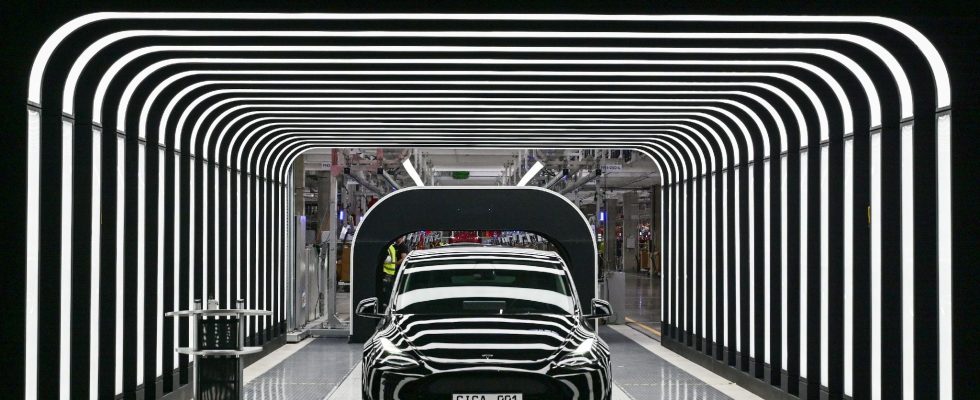It was his boss Elon Musk who announced it in person, in an email sent to his employees. Electric automobile giant Tesla will cut “more than 10%” of its workforce around the world, or a total of more than 14,000 jobs.
In his letter, the American leader explains that Tesla “has grown rapidly” in recent years, growth which has created “duplications […] in certain activities”, according to him. Elon Musk indicates that the manufacturer is “preparing for its next phase of growth” and seeks, in doing so, to achieve “cost savings” and “productivity gains”. “We have made an in-depth analysis and made the decision to reduce our workforce by more than 10% globally,” said the entrepreneur.
In its latest annual report, Tesla indicated that it had around 140,000 employees at the end of December, which means that the manufacturer will let go of at least 14,000 employees. Asked by AFP, Tesla did not immediately respond. “There is nothing I hate more” than making layoffs, “but we have to go through it,” wrote Elon Musk. “It will lean us, make us more innovative and mobilized for our next growth cycle.” The last major cut in Tesla’s workforce dates back to mid-2022, when the manufacturer also fired 10% of its employees.
Drop in deliveries at the start of the year
After years of success, the American automobile manufacturer is experiencing a more delicate period. It gave way to the Chinese BYD as the world’s leading manufacturer of electric vehicles in the last quarter of 2023. Generally speaking, Tesla, which has positioned itself from the outset rather in the high-end segment, is suffering from competition from Chinese cars in the very low price.
The start of 2024 confirmed this bad patch for the American manufacturer, which sold far fewer cars than expected. Thus, Tesla’s deliveries in the first quarter totaled 386,810 vehicles, compared to the 457,000 expected by analysts’ consensus. A clear drop also compared to the first quarter of 2023, when Tesla delivered just over 422,800 cars (-8.5%). Its production also declined, to 433,371 vehicles (-8.5%).
To return to these delivery levels, we must go back to the year 2022, where production was largely affected by Covid and the very strict confinement periods in China, where a large number of Tesla cars are produced. “First quarter deliveries were a nightmare, with Chinese and global demand for electric cars weakening,” said analysts at Wedbush Securities. “Tesla is stuck between two waves of growth and investors’ patience is starting to wear thin,” they added.
A difficult context for the entire electricity sector
But more broadly, the entire electric car industry is in difficulty. Chinese automaker BYD, Tesla’s No. 1 competitor, delivered just 300,114 battery electric vehicles in the first quarter, down 43% from the final three months of last year. Renault’s electric subsidiary, Ampere, has for its part decided to cancel its IPO at the start of 2024, mainly due to “current market conditions”. This is due to sluggish demand linked to sales prices that are still high, difficulties in accessing charging stations that are still significant, or even reductions in public subsidies for the sector.
According to the American media Bloomberg, this difficult period was also anticipated within Tesla, which had been hinting since the beginning of 2024 of this upcoming workforce reduction. The manufacturer’s managers were thus asked to justify that the position of each of their employees was essential. Some employees also learned late last year that the company would no longer offer merit bonuses as part of the annual performance review. “We just have to look for every penny we can,” Vaibhav Taneja, the company’s chief financial officer, explained during Tesla’s latest earnings conference call on January 24.
In addition, in its press release announcing its results for the first quarter of 2024, Tesla highlighted “factory shutdowns resulting from ship hijackings caused by the Red Sea conflict”, but also “an arson at the gigafactory of Berlin” as factors which also caused this drop in deliveries.
But more broadly, it is a new turning point that seems to be taking place for Tesla. Also this Monday, the manufacturer’s vice-president, Drew Baglino, announced his departure from X, even though he was one of the best-known faces of the manufacturer, where he spent 18 years. Also according to Bloomberg, another vice-president, Rohan Patel, will also leave the company. But at the center of the game, still and always Elon Musk, engaged on all fronts, from SpaceX to Neuralink, via Tesla, and obviously X (ex-Twitter).
